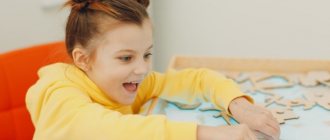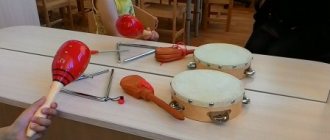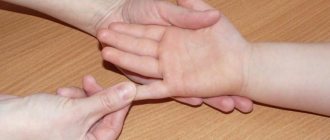The maturation and growth of children is a very peculiar process, which is distinguished by many subtleties and nuances. And every person who is a parent must certainly take a direct part in the development of his child. And this means not only, as they say, teaching the mind, sending it to kindergarten and school, as well as providing the child with everything necessary for a normal life, but also more subtle actions. One of these is the development of fine motor skills.
Why do you need to develop fine motor skills?
The question of why it is necessary to develop fine motor skills is very relevant, because Many people don’t understand why this is needed at all.
To begin with, it is worth noting that in general hand motor skills are most directly developed with the development of speech. And this is far from a myth, as it might seem at first glance. Research by scientists has shown that, from an anatomical point of view, approximately a third of the total area of the motor projection of the cerebral cortex is occupied by the projection of the hands, which is located very close to the speech zone.
Taking this into account, an assumption has emerged according to which subtle movements of the fingers have a formative and developmental effect on the child’s speech function. For this reason, if you want to teach your child to speak, you should not only train his articulatory apparatus, but also develop fine motor skills in every possible way, namely, the movement of his fingers.
But there is something else that definitely needs to be mentioned: fine motor skills of the hands develop not only speech. In addition, it interacts with thinking, imagination, motor and visual memory, observation, coordination and attention.
It is also necessary to develop fine motor skills for the reason that the entire future life of a still small person will require him to use coordinated and precise movements of his hands and fingers. Take at least very basic actions: fastening and unbuttoning buttons and locks, tying shoelaces, putting on and taking off clothes, drawing and writing, working with a computer and much more. It would seem simple, but a person will not be able to perform any of this properly if his fine motor skills are not developed.
But when should you start developing fine motor skills?
Consultation “What are fine motor skills and why is it so important to develop them”
Antonina Pavlova
Consultation “What are fine motor skills and why is it so important to develop them”
“What are fine motor skills?
and why it is so important to develop it .”
How often do we hear the expression “ fine motor skills ”
.
What are fine motor skills ?
Fine motor skills are a set of coordinated human actions aimed at performing precise small movements with the hands and fingers and toes.
The area of fine motor skills includes many different movements: from primitive gestures, such as grasping objects, to very small movements , on which, for example, human handwriting . The importance of fine motor skills is very great ! It is directly related to the full development of speech . Why ? Our brain is designed in such a way that separate centers are responsible for certain operations. The brain centers responsible for motor skills and speech are located nearby and closely interact with each other. By developing fine motor skills of the hand , we activate these parts of the brain and neighboring ones. And the neighboring ones are precisely responsible for the development of speech . Thus, the development of speech and the development of fine motor skills of the hand are interdependent . The connection between finger motor skills and speech function was confirmed by researchers at the Institute of Physiology of Children and Adolescents. Fine motor skills of the hands are responsible not only for speech, but also interact with such higher properties of consciousness as attention, thinking, coordination in space, imagination, observation, visual and motor memory, and speech.
The level of development of fine motor skills is one of the indicators of a child’s intellectual readiness for school. A child who has a high level of development of fine motor skills (he has mobile and dexterous fingers, will learn to speak without much difficulty, speech will develop correctly . He can reason logically, he has developed memory , attention, and coherent speech. A preschooler with a low level of motor skill development gets tired quickly . His attention quickly dissipates, a feeling of anxiety appears. It is difficult for him to complete tasks related to writing, for example, to circle any figure. In the future, this can lead to a lag in studies. Therefore, the correct and methodical development of movements of the fingers and hands stimulates speech the development of the child in general and has a beneficial effect on the correction of speech defects in particular.
start working on developing fine motor skills from a very early age. Already an infant can massage his fingers, thereby influencing the active points associated with the cerebral cortex. In early and early preschool age, you need to perform simple exercises, accompanied by a poetic text, and do not forget about developing basic self-care skills: buttoning and unbuttoning buttons, tying shoelaces, etc. And, of course, in older preschool age, work on developing fine motor skills and coordination of movements hands should become an important part of preparation for school, in particular for writing.
The development of fine motor skills is also important because the child’s entire future life will require the use of precise, coordinated movements of the hands and fingers, which are necessary to perform many different everyday and educational activities: dressing, holding a spoon, pencil, drawing and writing, tying shoelaces, fasten buttons.
What exercises will help your child improve his skills?
Finger gymnastics.
"Finger games"
- this is a dramatization of any rhymed stories or fairy tales using the fingers.
Many games require the participation of both hands, which allows children to navigate the concepts of “right”
,
“left”
,
“up”
,
“down”,
etc. It is recommended to use exercises in which each finger is trained separately (after all, the cerebral cortex has a separate projection area for each finger, movements are necessary for tension, relaxation, and stretching.
The effectiveness of classes and children’s interest in them can be increased if finger gymnastics exercises are carried out while reading rhymes, fairy tales, stories to children, working with them on nursery rhymes, jokes, and any speech material. While listening to it, children, together with an adult, “stage” the content of the listening material using finger movements and images of characters, their actions, etc. Children learn the finger movements learned in such classes in the future in independent dramatization games, improving the motor skills of their fingers. For the versatile, harmonious development of motor functions of the hand, training of three types of components is necessary: compression, stretching, relaxation - following medical terminology - a combination of alternating contraction and relaxation of flexors - flexor muscles and extensors - extensor muscles.
The duration of finger training depends on the age of the children (younger ages up to three or four years, the recommended time is from 3 to 5 minutes, in middle and older preschool age - 10-15 minutes a day). Some of the exercises in which the table surface was used are performed while sitting at the table. Thus, finger exercises, when skillfully included in the context of various activities and household chores, can contribute to the development in children of elements of their motor behavior determined by the play, everyday or educational situation.
Applications.
Children can make compositions - appliqués - from cut out figures. To begin with, it is more convenient to cut out geometric shapes and figures from colored magazines, and with an adhesive pencil, fix them on a sheet. If the child is still small and you are afraid to give him scissors, let him tear pictures from a magazine or newspaper with his hands - whatever happens; and you will paste the torn pieces onto a blank piece of paper, giving them some shape. It can make a meaningful collage.
Games with cereals, beads, buttons, small pebbles .
These games have an excellent tonic and healing effect. Children are asked to sort, guess with their eyes closed, roll between the thumb and forefinger, press alternately with all the fingers of both hands on the table, while trying to make rotational movements. You can teach your child to roll two walnuts or pebbles with the fingers of one hand, with the fingers of one hand, or with a hexagonal pencil between two palms. excellent for developing the hand. You can string: buttons, beads, horns and pasta, dryers, etc. You can make beads from cardboard circles, squares, hearts, leaves, rowan berries.
You can invite children to lay out letters, silhouettes of various objects from small objects : seeds, buttons, twigs, etc. Educational games : puzzles, mosaics, magnetic figures, frames and inserts, construction sets , cubes, wooden pyramids.
The listed game options develop fine motor skills of the hand (sequence and accuracy of movements, coordinate the work of the eyes and hands ( develop eye accuracy , sense of symmetry, promote the development of spatial , figurative, logical and associative thinking, develop memory , attention, imagination and creativity of the child, fantasy , perception of color, shape and size of an object. develop on the basis of different sizes, shapes and materials of toys. Such games train the ability to analyze information and make decisions taking into account conditions, the ability to act according to a model and independently, train perseverance, patience, concentration on activities, accuracy and the ability to receive aesthetic pleasure from the final result. All this has a formative influence on the mental and personal development of the child . This type of games also has a beneficial effect on preparation for school (especially in mastering writing)
.
All activities involving the use of small objects must be carried out under the strict supervision of adults!
Modeling from plasticine, clay and salt dough.
You can make single parts or several at once and combine them into compositions. We make sausages, rings, balls; We cut the plasticine sausage with a plastic knife into many small pieces , and then mold the pieces again. From each small piece we make a cake or a coin. (You can press a real coin or a flat toy onto the cake to make an imprint.)
We paste the resulting cakes over jars, twigs, etc. etc. Laying out a given pattern from plasticine with balls, sausages on plywood or a sheet of cardboard.
Pasting a glass bottle with plasticine and giving it the shape of a vase, teapot, etc.
Modeling of geometric shapes, numbers, letters.
Sand therapy.
The malleability of sand provokes the desire to create a miniature of the real world from it. A sand painting created by a child is a creative product. The main emphasis is on the child’s creative self-expression, thanks to which, on an unconscious-symbolic level, internal tension is released and ways of development .
Find a large box and fill it halfway with washed and dried river sand. Show your child the toy that you will hide in this sand, and do this when he turns away. You can gradually increase the number of hidden toys.
Invite your child to model a sand projection. For example, in accordance with the child’s experience, ask him to depict a zoo, pets, forest, etc. Let the child himself select the necessary materials and model the space.
Design and simulate a sand projection with various landscapes (mountains, ponds, plains, etc.)
based on lexical topics familiar to the child
(for example, wild animals)
. Use figurines of pets to construct projections. Invite your child to correct the picture. The child himself must choose the correct animal figures and place them in their characteristic landscapes.
Presentation of a fairy tale familiar to the child. The child independently chooses the props and builds the scenery. The fairy tale can be played out entirely according to the plot, or a familiar plot can be taken as a basis, and the child comes up with and plays out his own ending to the fairy tale.
Cutting with scissors.
Particular attention is paid to mastering basic cutting techniques - straight cutting skills, the ability to cut various shapes (rectangular, oval, round)
.
When obtaining symmetrical shapes by folding paper folded like an accordion (round dance)
or diagonally (snowflakes), children must learn that they are not cutting out the whole shape, but half of it. Before you start cutting out the silhouette, you should think about where, from what angle, in which side of the sheet, direct the scissors, i.e. plan the upcoming action. The game of cutting out patterns from folded pieces of paper has a remarkable property: no matter how clumsily the child cuts, you will still get a pattern that vaguely resembles a snowflake or a star.
Drawing, coloring.
Coloring is one of the easiest activities to do. At the same time, it continues to be a means of developing coordinated actions of the visual and motor analyzers and strengthening the motor apparatus of the writing hand. It is necessary to teach children to paint carefully, without going beyond the contours of the depicted objects, evenly applying the desired color. In the process of drawing, children develop not only general ideas and creativity, deepen their emotional relationship to reality, but also form elementary graphic skills that are so necessary for the development of manual dexterity and mastering writing. By drawing, children learn to properly handle graphic material and master various visual techniques; they develop fine muscles of the arm . You can draw with black and colored pencils, felt-tip pen, chalk, watercolors, and gouache.
Drawing with different materials requires different degrees of pressure in order to leave a mark on the paper from the writing object. This also contributes to the development of manual skills .
Of course, drawing promotes the development of small muscles of the hand and strengthens it. But we must remember that when learning to draw and write, the positions of the hand, pencil, notebook (sheet of paper, methods of drawing lines) are specific.
Various non-traditional techniques can be used.
Monotype: paint of different colors is applied to a sheet of paper. Then another sheet is superimposed on the sheet, and the prints are given a certain shape using a brush, pencil, or felt-tip pen.
Splatter: Dip a brush into the paint and then splatter the paint onto a piece of paper using your fingers or a pencil. In this way, you can create the background of the picture.
Blotography: paints are applied to a sheet of paper in any order. After applying the drawing with a pencil or felt-tip pen, they give some outline and create an image.
Tamponing: applying paint to paper using cotton swabs or sponges.
Freehand printing: If your child is extremely reluctant to paint with a brush, encourage him to paint with his fingers. You can draw with one, two, or all fingers at once: each finger is dipped in paint of a certain color, and then placed on paper in turn. This is how you get fireworks or beads, etc. It is best to finish the drawing with felt-tip pens or pencils. You can paint your hand with a brush and then make prints on paper.
For small children, it is good to use special “edible paints”
(sold in stores)
. You can come up with such paints yourself: jam, jam, mustard, ketchup, whipped cream, etc. can decorate your drawing or dish.
When selecting game exercises and game material, a number of principles should be taken into account:
• take into account the age and individual capabilities of the child (both simple and complex types of work deprive the child of interest in performing);
• it is important to remember that only joint activity between an adult and a child will give a positive result. Personal relationships between an adult and a child should be built on the basis of trust, mutual understanding, and goodwill (the child knows that he will receive the necessary help in case of difficulties)
;
• an activity is a game (mastering new information should bring joy to children and be an interesting process);
• praise the child;
• the game must be completed to the end (even if it caused difficulties)
;
• during the lesson, the child should not be distracted by foreign objects - remove them from sight. Do not give the toys you will be playing with for constant play, otherwise the baby will lose interest in them;
• work on developing movements of the fingers and hands should be carried out systematically;
• take into account the duration of the work (the activity should captivate the child, and not tire him, depriving him of strength)
;
• exercises are practiced gradually and are initially performed passively, with the help of adults;
• gradual complication of game material, exercises (from simple to complex)
.
tasks and exercises aimed at developing fine motor skills . If you wish, especially if you use your imagination and imagination, you can come up with them endlessly. And the main thing here is to take into account the individual characteristics of each child, his age, mood, desire and capabilities. Fingers will not become skillful right away. Games and exercises, finger exercises, carried out systematically from a very early age, help children confidently hold a pencil and pen, braid their hair and lace their shoes independently. Build from small parts of a construction set , sculpt from clay and plasticine, etc. Thus, if the fingers develop , the child’s speech and thinking will develop .
When should I start developing fine motor skills?
Experts recommend that children begin developing fine motor skills at eight months of age. It is during this period that the fingers will already be amenable to active training. You can, of course, start developing fine motor skills earlier by inviting your baby to play with objects of different textures, shapes and sizes, as well as with special toys, which, by the way, are easily made from what you have at home, but it’s not a guarantee that they will result. So, eight months is the most optimal period.
And the next completely logical question would be: “What are the ways to develop fine motor skills?” This is exactly what we will answer below.
By and large, the choice of means for developing fine motor skills is quite diverse. Moreover, the more methods you use, the more effective and complete the classes will be, and the result will become more tangible.
So, let's look at the most common and popular ways to develop fine motor skills.
What it is?
What most of us usually call finger dexterity is actually a complex process that involves various systems of the body. Hand motor skills are the ability to make precise and coordinated movements with the fingers. They can be varied, ranging from grabbing objects to creating pictures and juggling. The common denominator is the involvement of the musculoskeletal system, muscles, nervous system and vision in the movement.
If at least one of the systems does not cope with its task, then the desired result cannot be achieved. For example, if nothing is done to develop a child's fine motor skills, he will have difficulty learning to write legibly, will frequently drop objects, and will have difficulty playing sports. In addition, such skills are reflected in the quality of speech. In adulthood, insufficient finger training will cause clumsiness and problems in everyday life, so everyone should know how to develop fine motor skills. The good news is that if you make an effort and be patient, you can learn to control your movements, no matter how old you are.
Games with small pebbles, buttons, beads and cereals
Games with small pebbles, buttons, beads and cereals have an excellent developmental, healing and tonic effect on the child’s body. However, they should always be carried out under the supervision of an adult so that the child does not accidentally get hurt or eat one of the above items.
Such games include:
- Drawings from cereals. A piece of cardboard is taken and the child draws any image on it, for example, the sun. Then you need to take the safest glue and apply it along the contour of the drawing, and the child should put, for example, peas, beans or buckwheat on these lines. This game serves as an excellent workout for the muscles of the hands and fingers.
- Exercise using forceps. You need to give the child tongs and ask him to put beads, peas, etc. into a bottle with a narrow neck.
- Exercise using tweezers. The child is given tweezers, and with its help he transfers from one container to another and sorts small toys or the same cereal. In addition, it is very effective if the baby uses tweezers to transfer small toys or cereals into some kind of shaped container, for example, into an ice mold or for baking cakes.
- Sorting small items by size, shape and color. Ask your child to sort cereals, buttons, or beads by color, size, or shape.
Games and exercises aimed at developing fine motor skills
The main activity of preschool children is play. We have selected a variety of games and exercises for you, among which you will definitely find something that suits you and your child.
- Folding toys. We place a transparent container in front of the child and place small toys separately. We suggest putting toys into the container with your right hand. Then we pour them back and ask you to repeat the same actions with your left hand.
- Games with cereals. In one container we mix two types of cereals, for example, rice and buckwheat. It is necessary for the child to put these cereals into different containers. You can complicate the game by adding other small objects to the mixture of cereals, for example, beads, buttons, pebbles.
- Exercise for tearing a sheet of paper. First, draw random lines on a sheet of paper. We invite the child to tear the paper with his hands exactly along the drawn lines. You can complicate the task by depicting geometric shapes.
- Page turning exercise. As your child gets older, instead of tearing a sheet of paper, you can suggest flipping through the pages of a favorite book. This exercise also promotes the child's early interest in reading literature.
- Smoothing out a crumpled sheet of paper. We place a crumpled sheet of paper in front of the child and offer to smooth it out so that not a single bent corner remains. You can complicate the exercise by suggesting that you do it with one hand, while holding the sheet with your thumb.
- Games with cubes. We give the task to assemble various figures from cubes: a tower, a house, a car, etc. Pyramid rings are also suitable for these games. The tasks become more complicated as the child masters the construction of simple figures.
- Games with lacing. Available in various options. It can also be an unnecessary shoe that you can let your child lace and unlace. It could also be a card with holes for laces. In any case, the actions with these objects are the same and pursue the same goal - to teach the child to cope with shoelaces on his own, since this skill will be useful to him in the future.
- Exercises with counting sticks. Please place geometric shapes on the table. First, the child completes tasks according to the model, and then independently according to verbal instructions. An additional advantage of this exercise is the formation of elementary mathematical concepts.
- Games with lids. Here you can offer various containers and vessels with lids that the child will independently twist and unscrew. And if you tell your child that you can’t cope without him, you will give him a motive to become your main assistant.
- Finger drawing in the sand. Invite your child to draw geometric shapes or any other design he wishes with all his fingers one by one. Interaction with sand also has a positive effect on the central nervous system.
Finger games
“Finger” games are a kind of dramatization of some stories, most often rhyming, using fingers. You can start playing such games even up to one year, and then continue, slightly complicating your finger movements. You can play until the end of primary school age.
Most of these games involve the use of two hands, thanks to which children begin to understand what “down”, “up”, “left”, “right”, etc. are. To obtain the greatest effect, these finger exercises must be structured in such a way that tension, relaxation, clenching and unclenching of the hands alternately change, and isolated movements of all fingers are also involved.
Modeling from clay, plasticine or salt dough
Today it is a well-known fact that working with such “materials” as clay, plasticine and salt dough perfectly develops fine motor skills and also has a wonderful effect on the imagination.
What you can do:
- Cover glass bottles with plasticine and shape them into teapots, vases, jugs, etc.
- Lay out specific designs from plasticine in the form of balls, sausages on cardboard or plywood
- Make impressions on clay, dough or plasticine by pressing on them with fingers, toys, coins, buttons, etc.
- Make balls, rings, sausages, then cut into separate pieces, and then put them together again (you can shape individual pieces)
- Make several different parts and put them together into a composition (you can prepare the elements yourself, and after that give them to the child to work with)
Exercises using additional objects
In addition to the fact that exercises using additional objects are very exciting and entertaining, they excellently contribute to the development of spatial imagination.
Among these games are:
- Mosaic. To begin with, it is enough that the baby simply inserts mosaic elements into the base. Subsequently, you should specify a specific image or shape for the child to post it. The ideal option would be a mosaic with different hats.
- Abacus. Give your child the task of moving the counting rings from one end to the other. To develop counting skills, you can also move the rings in order.
- Threads. This refers to the usual winding and unwinding of threads on various objects. You can, for example, select figures of some animals in advance, and the child will wrap them with threads, giving them color. These same figures can be used for games.
- Paper clips. To play this game, you will need regular colored paper clips and several sheets of colored paper. The task is to collect leaves of the same color into a small bundle, and then fasten them with the same paper clip.
- Bolts and nuts. Nothing fancy is required - just large bolts and nuts. And the point of the game is even simpler - screw the nuts onto the bolts.
- Clothespins. Take clothespins and attach them to rope, cardboard or any other base. The task can also be complicated: some identification marks are glued onto the base and clothespins, for example, colored cards or letters, and the child attaches the clothespins to the corresponding bases.
In fact, this list of games for developing fine motor skills is not exhaustive. For this purpose, you can find some other games or come up with your own. Remember that anything is suitable for developing motor skills: water, sand, laces, wire, paper, etc. and so on.
And one more thing: developing fine motor skills is useful not only for children, but also for adults, so even if you don’t have children, go to the store for plasticine, and we assure you, the evening will be usefully spent.
We also recommend reading:
- Storytelling
- Piaget's theory of cognitive development
- How to get your child interested in reading?
- Masaru Ibuka “After three it’s too late” - summary
- How to teach a child to read: rules, tips and tricks
- Speech thinking in children and adults: what is it and why is it needed?
- How to teach a child to write beautifully
- A selection of courses for children and parents
- Dyslexia: Definition, Causes, Symptoms and Treatment
- A person's main limiting belief
- Top 5 most important soft skills for every child
Key words:1Children
When to start development in children?
Fine motor skills are an ability that is naturally developed in every child from the moment they are born. Grasping skills are the first to appear, then the baby learns to transfer things from one hand to another, then he trains to perform more precise movements with his fingers. Experts say that by the age of 2 years, a child should be able to use a spoon and brush without problems, gradually expanding the range of movements performed.
Parents need to think about how to develop fine motor skills in their son or daughter in advance, so that immediately after birth they can gradually apply the acquired knowledge in practice. The faster a child masters simple exercises, the easier it will be for him at school and the sooner he will begin to speak clearly and understandably. You can achieve a positive effect if you turn exercise into a game and do the exercises regularly.
At the initial stage, the development of fine motor skills in children can be carried out with the help of:
- Gently stroking and massaging the fingers followed by rubbing;
- Games that teach how to hold objects correctly, such as ridged toys and balls with uneven surfaces;
- Gymnastics of fingers by tearing paper, playing with cereals and creating figures from plasticine;
- Practicing practical skills (how to fasten buttons, how to brush your teeth and wash your hands, etc.).
Parents need to be close to the child while learning a new exercise and support him, because it is very rare to immediately perform the movements correctly. Other taboos include raising your voice and promising to buy or allow the child something if he completes the task.










